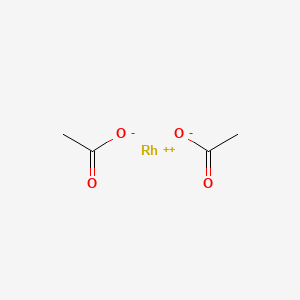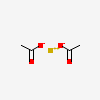Rhodium (II) acetate
- Rhodium(II) acetate
- 5503-41-3
- aceticacid,rhodium(2+)salt
- rhodium(2+);diacetate
- Rhodium (II) acetate
- Create:2005-08-08
- Modify:2025-01-18
 Dirhodium tetraacetate (annotation moved to).
Dirhodium tetraacetate (annotation moved to).
- Rhodium(II) acetate
- 5503-41-3
- aceticacid,rhodium(2+)salt
- rhodium(2+);diacetate
- Rhodium (II) acetate
- Rhodium acetate, browN, water soluble
- Acetic acid, rhodium(2+) salt
- 15956-28-2
- diacetoxyrhodium
- rhodium(II)acetate
- Rhodium (II) acetate dimer dihydrate
- rhodium(II)diacetate
- -rhodium(2+) diacetate
- C4H6O4Rh
- SCHEMBL196205
- DTXSID30203567
- lambda(2)-rhodium(2+) diacetate
- TETRAKIS(ACETO)DIRHODIUM(II)
- ?(2)-rhodium(2+) bis(acetate ion)
- AKOS015892709
- NS00088789
 Dirhodium tetraacetate (annotation moved to)
Dirhodium tetraacetate (annotation moved to)
H315 (85.7%): Causes skin irritation [Warning Skin corrosion/irritation]
H319 (71.4%): Causes serious eye irritation [Warning Serious eye damage/eye irritation]
H412 (14.3%): Harmful to aquatic life with long lasting effects [Hazardous to the aquatic environment, long-term hazard]
P264, P264+P265, P273, P280, P302+P352, P305+P351+P338, P321, P332+P317, P337+P317, P362+P364, and P501
(The corresponding statement to each P-code can be found at the GHS Classification page.)
Aggregated GHS information provided per 7 reports by companies from 5 notifications to the ECHA C&L Inventory. Each notification may be associated with multiple companies.
Reported as not meeting GHS hazard criteria per 1 of 7 reports by companies. For more detailed information, please visit ECHA C&L website.
There are 4 notifications provided by 6 of 7 reports by companies with hazard statement code(s).
Information may vary between notifications depending on impurities, additives, and other factors. The percentage value in parenthesis indicates the notified classification ratio from companies that provide hazard codes. Only hazard codes with percentage values above 10% are shown.
Skin Irrit. 2 (85.7%)
Eye Irrit. 2A (71.4%)
Aquatic Chronic 3 (14.3%)
- EPA DSSToxAcetic acid, rhodium(2+) salthttps://comptox.epa.gov/dashboard/DTXSID30203567CompTox Chemicals Dashboard Chemical Listshttps://comptox.epa.gov/dashboard/chemical-lists/
- European Chemicals Agency (ECHA)LICENSEUse of the information, documents and data from the ECHA website is subject to the terms and conditions of this Legal Notice, and subject to other binding limitations provided for under applicable law, the information, documents and data made available on the ECHA website may be reproduced, distributed and/or used, totally or in part, for non-commercial purposes provided that ECHA is acknowledged as the source: "Source: European Chemicals Agency, http://echa.europa.eu/". Such acknowledgement must be included in each copy of the material. ECHA permits and encourages organisations and individuals to create links to the ECHA website under the following cumulative conditions: Links can only be made to webpages that provide a link to the Legal Notice page.https://echa.europa.eu/web/guest/legal-noticeRhodium (II) acetatehttps://echa.europa.eu/substance-information/-/substanceinfo/100.024.403Tetrakis[μ-(acetato-O:O')]dirhodiumhttps://echa.europa.eu/substance-information/-/substanceinfo/100.036.425Tetrakis[μ-(acetato-O:O')]dirhodium (EC: 240-084-8)https://echa.europa.eu/information-on-chemicals/cl-inventory-database/-/discli/details/125073
- New Zealand Environmental Protection Authority (EPA)LICENSEThis work is licensed under the Creative Commons Attribution-ShareAlike 4.0 International licence.https://www.epa.govt.nz/about-this-site/general-copyright-statement/
- Haz-Map, Information on Hazardous Chemicals and Occupational DiseasesLICENSECopyright (c) 2022 Haz-Map(R). All rights reserved. Unless otherwise indicated, all materials from Haz-Map are copyrighted by Haz-Map(R). No part of these materials, either text or image may be used for any purpose other than for personal use. Therefore, reproduction, modification, storage in a retrieval system or retransmission, in any form or by any means, electronic, mechanical or otherwise, for reasons other than personal use, is strictly prohibited without prior written permission.https://haz-map.com/AboutRhodium(II) acetate dimerhttps://haz-map.com/Agents/17098
- Japan Chemical Substance Dictionary (Nikkaji)
- WikidataRhodium (II) acetate dimer dihydratehttps://www.wikidata.org/wiki/Q72506636
- WikipediaRhodium(II) acetatehttps://en.wikipedia.org/wiki/Rhodium(II)_acetate
- PubChem
- GHS Classification (UNECE)GHS Classification Treehttp://www.unece.org/trans/danger/publi/ghs/ghs_welcome_e.html
- NORMAN Suspect List ExchangeLICENSEData: CC-BY 4.0; Code (hosted by ECI, LCSB): Artistic-2.0https://creativecommons.org/licenses/by/4.0/NORMAN Suspect List Exchange Classificationhttps://www.norman-network.com/nds/SLE/
- MolGenieMolGenie Organic Chemistry Ontologyhttps://github.com/MolGenie/ontology/


 CID 176 (Acetic Acid)
CID 176 (Acetic Acid) CID 23948 (Rhodium)
CID 23948 (Rhodium)